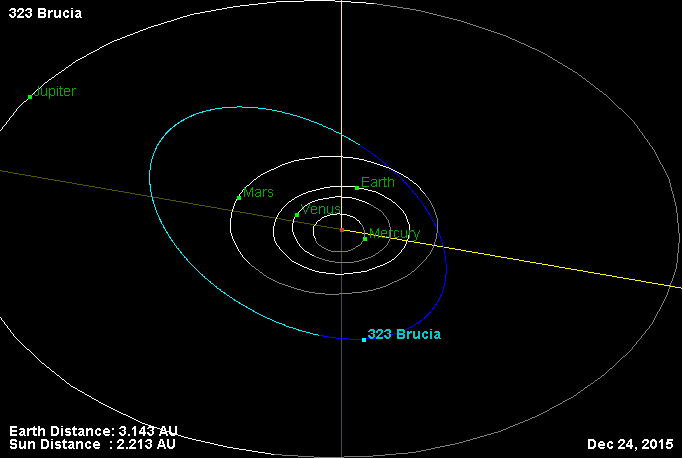323 Brucia on:
[Wikipedia]
[Google]
[Amazon]
Brucia (
 ''Brucia'' was also the first of over 200 asteroids discovered by
''Brucia'' was also the first of over 200 asteroids discovered by Webcite archive of asteroid 6454 with Epoch 2016
/ref> ''Brucia'' has a synodic
Asteroid Lightcurve Database (LCDB)
query form
)
Dictionary of Minor Planet Names
Google books
– Observatoire de Genève, Raoul Behrend
– Minor Planet Center * * {{DEFAULTSORT:Brucia 000323 000323 Discoveries by Max Wolf Named minor planets 000323 18911222 18911222
minor planet designation
A formal minor-planet designation is, in its final form, a number–name combination given to a minor planet (asteroid, centaur, trans-Neptunian object and dwarf planet but not comet). Such designation always features a leading number (catalog ...
: 323 Brucia) is a stony Phocaea
Phocaea or Phokaia (Ancient Greek: Φώκαια, ''Phókaia''; modern-day Foça in Turkey) was an ancient Ionian Greek city on the western coast of Anatolia. Greek colonists from Phocaea founded the colony of Massalia (modern-day Marseille, in ...
asteroid
An asteroid is a minor planet of the inner Solar System. Sizes and shapes of asteroids vary significantly, ranging from 1-meter rocks to a dwarf planet almost 1000 km in diameter; they are rocky, metallic or icy bodies with no atmosphere. ...
and former Mars-crosser
A Mars-crossing asteroid (MCA, also Mars-crosser, MC) is an asteroid whose orbit crosses that of Mars. Some Mars-crossers numbered below 100000 are listed here. They include the two numbered Mars trojans 5261 Eureka and .
Many databases, for in ...
from the inner regions of the asteroid belt
The asteroid belt is a torus-shaped region in the Solar System, located roughly between the orbits of the planets Jupiter and Mars. It contains a great many solid, irregularly shaped bodies, of many sizes, but much smaller than planets, c ...
, approximately in diameter. It was the first asteroid to be discovered by the use of astrophotography
Astrophotography, also known as astronomical imaging, is the photography or imaging of astronomical objects, celestial events, or areas of the night sky. The first photograph of an astronomical object (the Moon) was taken in 1840, but it was no ...
.
Description
 ''Brucia'' was also the first of over 200 asteroids discovered by
''Brucia'' was also the first of over 200 asteroids discovered by Max Wolf
Maximilian Franz Joseph Cornelius Wolf (21 June 1863 – 3 October 1932) was a German astronomer and a pioneer in the field of astrophotography. He was the chairman of astronomy at the University of Heidelberg and director of the Heidelberg-K ...
, a pioneer in that method of finding astronomical object
An astronomical object, celestial object, stellar object or heavenly body is a naturally occurring physical entity, association, or structure that exists in the observable universe. In astronomy, the terms ''object'' and ''body'' are often u ...
s. Discovered on December 22, 1891, it was named in honour of Catherine Wolfe Bruce, a noted patroness of the science of astronomy
Astronomy () is a natural science that studies celestial objects and phenomena. It uses mathematics, physics, and chemistry in order to explain their origin and evolution. Objects of interest include planets, moons, stars, nebulae, g ...
, who had donated $10,000 for the construction of the telescope used by Wolf.
The asteroid is a member of the Phocaea family The Phocaea family ( ; adj. ''Phocaean''; ) is a collisional family of asteroids located between 2.25 and 2.5 AU in the inner region of the asteroid belt. Phocaea asteroids are of stony S-type composition and have orbits with eccentricities ...
(), a large family
Family (from la, familia) is a group of people related either by consanguinity (by recognized birth) or affinity (by marriage or other relationship). The purpose of the family is to maintain the well-being of its members and of society. Idea ...
of stony S-type asteroid
S-type asteroids are asteroids with a spectral type that is indicative of a siliceous (i.e. stony) mineralogical composition, hence the name. They have relatively high density. Approximately 17% of asteroids are of this type, making it the secon ...
s with nearly two thousand known members. It was an outer Mars-crossing asteroid
A Mars-crossing asteroid (MCA, also Mars-crosser, MC) is an asteroid whose orbit crosses that of Mars. Some Mars-crossers numbered below 100000 are listed here. They include the two numbered Mars trojans 5261 Eureka and .
Many databases, for in ...
with perihelion
An apsis (; ) is the farthest or nearest point in the orbit of a planetary body about its primary body. For example, the apsides of the Earth are called the aphelion and perihelion.
General description
There are two apsides in any elli ...
less than 1.666 AU until July 2017. For comparison, asteroid 4222 Nancita will become a Mars-crosser in June 2019. was a Mars-crossing asteroid until January 2016./ref> ''Brucia'' has a synodic
rotation period
The rotation period of a celestial object (e.g., star, gas giant, planet, moon, asteroid) may refer to its sidereal rotation period, i.e. the time that the object takes to complete a single revolution around its axis of rotation relative to the ...
of 9.463 hours (as of 1998). According to the survey carried out by the Infrared Astronomical Satellite, ''Brucia'' measures 35.82 kilometers in diameter and its surface has an albedo
Albedo (; ) is the measure of the diffuse reflection of solar radiation out of the total solar radiation and measured on a scale from 0, corresponding to a black body that absorbs all incident radiation, to 1, corresponding to a body that refle ...
of 0.1765.
References
External links
Asteroid Lightcurve Database (LCDB)
query form
)
Dictionary of Minor Planet Names
Google books
– Observatoire de Genève, Raoul Behrend
– Minor Planet Center * * {{DEFAULTSORT:Brucia 000323 000323 Discoveries by Max Wolf Named minor planets 000323 18911222 18911222